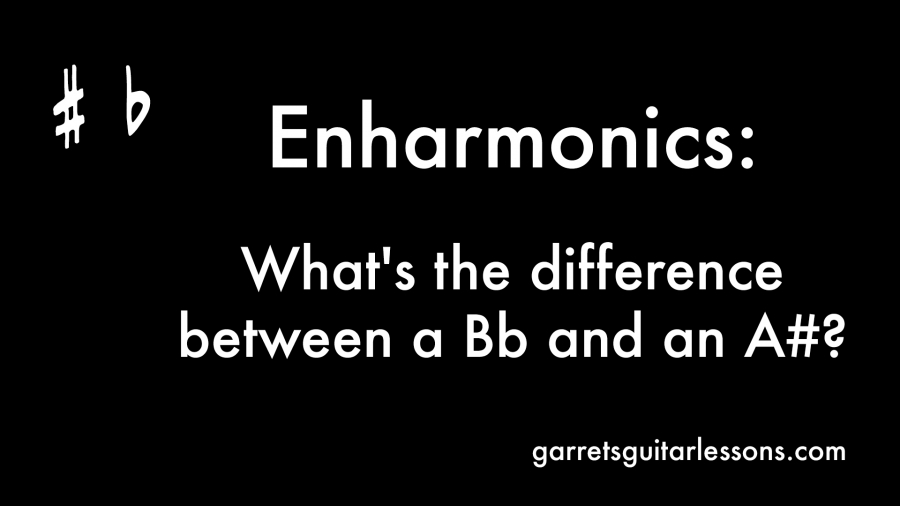They’re the same fret, but why would I call something a Bb instead of an A#? Why are there two names for the same note, same chord or same scale?
The basic answer is when spelling out a scale, each note name gets one degree… not two. There is only one type of A note in a scale even though there are three types of A: A flat, A (natural) and A sharp. This goes with the rest of the notes as well.
So when spelling out a scale each letter gets one degree.
Let’s start with the A Scale (W – W – H – W – W – W – H | or | 1 – 2 – 3 – 4 – 5 – 6 – 7):
A – B – C# – D – E – F# – G#.
If you look at each of those notes, each one of the degrees has one letter. We wouldn’t want to call a G# an Ab in the key of A… the letter A is already taken as the root! Same thing with the C#, we wouldn’t want to call that a Db, based on D takes up the fourth degree of the scale.
Thinking of scales this way streamlines remembering how the scale degree interacts with with root. If we look at the key of Ab:
Ab – Bb – C – Db – Eb – F – G
Comparing A to Ab, we see that the same note letters correspond with the same degree in both keys. The D note is always going to be the 4th of an A scale, if it’s A natural, then the D is natural. Likewise if the A is flat then the D would be flat… but it’s still the 4th! This works with B and Bb, F and F#, D and Db, C and C#… you get the point. This cuts the work of memorizing each major scale in half as the degrees stay consistent even though the key may change.
What makes this weird is how you can get double flats, double sharps and even Cb and B#. When a note has a double flat, double sharp or Cb and B#, the tone (and fret) itself is what you’re thinking of: a Cb is actually a “B” note, a B# is actually a “C” note, an F* (double sharp) is actually a “G” note. The reason you’d call a note a Cb is to keep the degree of the scale relative to the root. Let’s look at the key of A#:
A# – B# – C* (double sharp) – D# – E# – F* (double sharp) – G* (double sharp).
These aren’t secret notes; B# = a “C” note, C* = a “D” note, F* = a “G” note and the G* = the “A” note, in terms of tone and fret, but the way it reacts to the root gives us all these goofy names. Like I said the D type is always the fourth of an A type scale… but this sure doesn’t make things easier.
The alternative is what… to have the scale spelled out: A# – C – D – D# – F – G – A? No way! Look, we have two degrees with the A letter, two degrees with the D letter, no B or E… this is confusing! Especially when conveying things to other musicians. So we know A# and Bb and technically the same note… what if we call it a Bb major scale instead?
Bb – C – D – Eb – F – G – A
Ahhhh… that’s better! No crazy double sharps or a B# note. This is why you’ll almost always (unless someone is cruel) will write in the key of Bb, not A#.
This is why on the Circle of 4ths (or 5ths) you see things written in a certain way, the key of Bb instead of A#, the key of Eb instead of D#, the key of B instead of Cb… to actually make it easier!
This doesn’t mean that flat keys are always right, or sharp keys are always right. It means that it depends on what is less confusing. Let’s take a look at a minor scale:
Natural Minor Scale: 1 – 2 – b3 – 4 – 5 – b6 – b7.
Okay, so let’s start with Ab, that one seemed like it fit pretty well so the Ab major scale is: Ab – Bb – C – Db – Eb – F – G. Now when I flat the appropriate notes to make it a minor it is:
Ab – Bb – Cb – Db – Eb – Fb – Gb.
Awhhhh man, look we have a Cb and an Fb. Who wants to think of an E note as an Fb? Not me.
…what if we look at it as a G# Minor?
G# – A# – B – C# – D# – E – F#
Hey look at that… much better!
So doing a little bit of thought in the short run on thinking of our enharmonics (how A# and Bb are the same note) can make memorizing scales easier, knowing how degrees interact with the root and avoid any crazy names.
Pretty cool, huh?
Related Lessons
Basic Guitar Overview + Note System | BO 1/10
What’s a Scale?! | UGT 1/8

